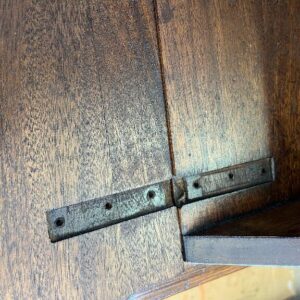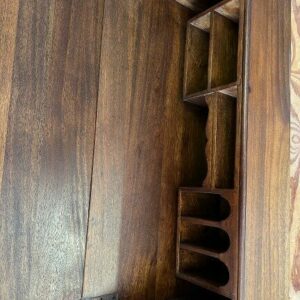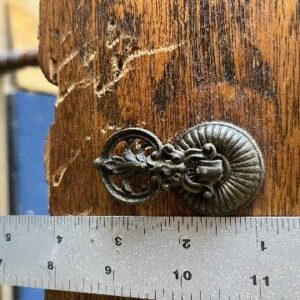I found this desk on the curbside and have been working to clean it up as best I could.
Having a difficult time finding the hinges for the drop leaf and was wondering if anyone could help. Can’t seem to find anything with square ends. There is also a drop pull that is missing. I’d like to fin the same ones that were on the drawer(shown in pic) but I’m not as concerned as I can likely find something close.
In either case, if folks have any ideas on where to find either I’d sure appreciate it.


















Replies
Start by knocking on the door of the home where you found the desk. They look to have been carefully removed. If the previous owner knew that the desk was destined for restoration they just might hand them over. (I would)
Short of that, find something that will cover the footprint of the old ones and either cut them to fit, or cut new mortises for them.
Thanks for the inputs. I snagged it over a year ago, about a thousand miles from my shop!
Still searching for something close to re-mortise, but most of what I see if much narrower.
Ball and Ball has box hinges which may work. They could custom make them for you as well.
https://ballandball.com/product-categories/table-hinges/page/2/
Whitechapel has a hinge they call a desk hinge:
https://whitechapel-ltd.com/242h28.html
You don't give the size. Maybe something like this will work:
https://www.amazon.com/Solid-Brass-Side-Hinges-Screws/dp/B081QMR567/ref=sr_1_14?keywords=brass+Hinges&qid=1707856368&s=industrial&sr=1-14-catcorr.
Do a web search for "antique drawer pull". You might not find a match, but you should find a suitable replacement.
The hinge needs to be 7" long(3.5"per side) 3/4" wide by 1/8" thick. There is no 'pull-out' runner for the flip down lid to rest on, so the hinge needs to support the writing surface when lowered.
Thanks for the links, but no joy.
https://www.vintagehardware.com/proddetail.php?prod=26267&optn0x0y1=1&gad_source=1&gclid=EAIaIQobChMI79nktJqphAMVe0p_AB0w7w9XEAQYASABEgIKzfD_BwE
This is the closest I can find.
I'm skeptical of the lack of support. Is there any evidence of folding lid supports along the sides? If the drawer is directly under the lid, is there any evidence that it is to be pulled out to be a support?
lji may have the solution, but I see no information on it's load capacity.
You might be best advised to post on an antique restoration site to see if someone is familiar with the piece. That lid has to be supported somehow and I don't think you can do it with just the hinge.
bilyo,
I agree regarding the lack of support. I wasn't sure what hinge it took, and whether it might be capable of supporting the lid when in use. Looking at pics on web, and I see most pieces have some sort of pull-out runners, but this piece has no evidence of such. The drawer sits 2" below the top section, so unless folks were writing at a 30 degree decline, I'm not sure how it was intended to work.
Good idea about a restoration forum. I'll look around and see if I can find one that might be able to help.
Find an artisan blacksmith to make you the hinges.
If you are unable to find any answers at an antique restoration forum site, I would be tempted to try the hinge that lji found and see how strong and rigid they are. If not satisfactory, then add simple chain supports that mount to each side of the lid. These will add good support without detracting too much from the originality. Please let us know what you find.
The hinge you discovered at vintage hardware appears it would work. Both in its ability to lock open at 180% and the size of the current mortise.
I ordered the hinges, still waiting for delivery. I wasn't able to find a restoration site, although my search was a bit weak. I did post to the Houzz web site, where responses were the same hinges I had already found. No one addressed the lack of lid support. Worst comes to worst, I'll make a small block of wood to 'chock' the lid when the drawer is open. This can't hurt, although its a bit crude.
You can buy 1/8 flat brass bar from Grainger. 1/8 x 1/2 x 6....$2.39 each.
https://www.grainger.com/product/APPROVED-VENDOR-360-Brass-Rectangular-Bar-803G67
If you take your hinges and brass bar to your local jeweler he should be able to cut the hinge and braze in the desired length so you have a nice square end. Then polish and drill....should cost very little total.
The hinges you found have the bar on top to create a stop to hold the lid in position. The problem I anticipate is that the bar is so short and so close to the pivot point that leverage will over come it and bend or break something or pull the screws out. If you find that to be true some longer supports will be called for; like this:
https://www.amazon.com/Deltana-TC82U3-Solid-12-Inch-Transom/dp/B00E4K911G/ref=sr_1_2?crid=3L7CS9M11AZLM&keywords=lid%2Bsupport%2Bchain&qid=1708196577&sprefix=lid%2Bsupport%2Bchain%2Caps%2C136&sr=8-2&th=1
Or this:
https://www.amazon.com/National-Hardware-N208-611-Folding-Support/dp/B000BQY82Y/ref=sr_1_80?crid=2FT4CR8U7295A&keywords=lid+support&qid=1708196376&sprefix=lid+support%2Caps%2C123&sr=8-80
I think you will find that the block you mention will suffer from the same problem, it will be so close to the pivot point that leverage will overcome it and perhaps break the lid if too much pressure is applied to the edge of the lid.
It may be that the hinge you ordered will suffice in supporting the lid. I'm curious. Please let us know.
Hinges arrived and appear to be able to do the job. I wouldn't try to get out of a chair using the lid for support, but for light duty writing, or model painting, I'm sure it will do just fine.
Thanks to all for your help.
Nice desk. Good find. I'm glad the hinges work. I'm amazed that they can handle the leverage. Thanks for reporting back.
That crude idea of chocking the top is tenable. Using the drawer bottom and a wood chock on both sides. Make them to flip up and down. Round the bottom end and use one screw fasten to the inside of drawn front. When they flip up, the side of the wood chock will need to touch the drawer side on each end. Of course, there will need to be something on the top side to protect the wood face. I don't think you should pull the drawer out more than halfway to use this method.